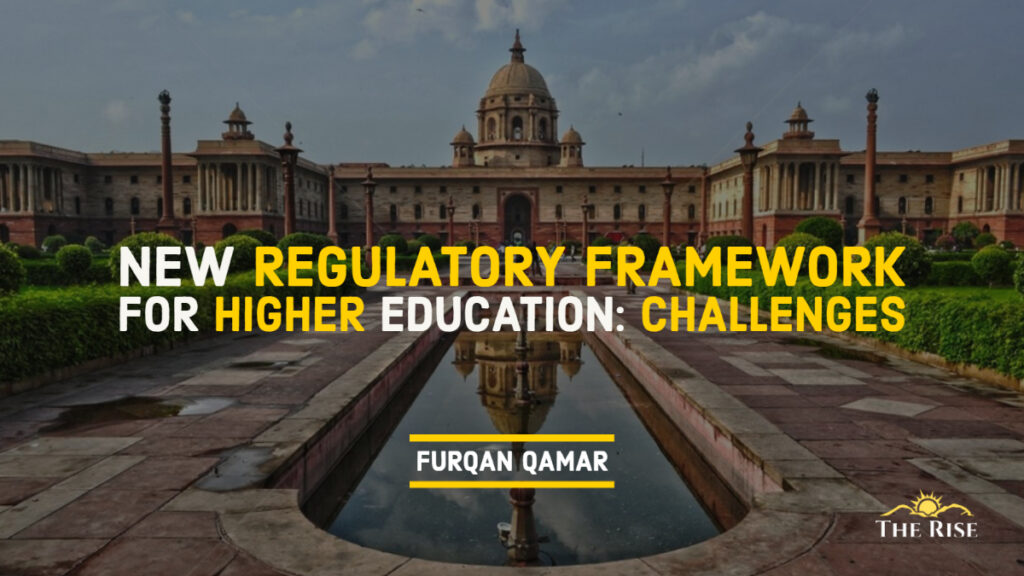While everyone has been recommending, since 2007, for an all-embracing single regulatory body to take care of all higher educational institutions and programmes, none has been able to provide details of deficiencies that have made the existing regulatory bodies dysfunctional. In the meantime, the idea of the single regulator has seen some major dilution. The first anniversary of NEP 2020 was celebrated with gusto, but there is still no sight of the single regulatory authority, even though the Finance Minister announced in the budget speech of 2021-22 that the new regulatory body shall be set up during that financial year itself. It must, therefore, be a real challenge to design a single regulatory body for higher education, which must meet the NKC’s idea of saving higher education from being ‘over-regulated and under governed” or the Kasturirangan Committee’s desire to evolve “light but tight” regulatory framework.
National Education Policy (NEP 2020) came into effect from 29th July 2020. One of the major recommendations of the policy has been about doing away with the multiplicity of regulatory bodies in higher education. It proposed to redefine the role of all existing regulatory bodies to become standard-setting bodies (SSBs) and replace them with a single regulatory body called the Higher Education Commission of India (HECI).
As the first anniversary of the NEP 2020 was celebrated with gusto around six months ago, this most critical recommendation of the policy is yet to take a shape, even though, the last year’s budget speech too had mentioned that during this financial year the proposed single regulatory body in higher education would be established.
Also Read: Anniversary of NEP 2020: Education needs intensive care
Changing the regulatory architecture of higher education appears to be proving more challenging than one would have thought and expected. The idea was first mooted by the National Knowledge Commission in its report to the nation in 2007. Its idea to establish an Independent Regulatory Authority for Higher Education (IRAHE) was scuttled by the Yashpal Committee report on the Revival and Rejuvenation of Higher Education which, in its report, argued for setting up the National Commission of Higher Education and Research (NCHER).
At one point of time, the idea of the single regulatory body replacing all others was promoted in the name and style of Higher Education Empowerment Regulation Agency (HEERA). So far, none has fructified. Perhaps, surmounting the challenges of conceptualizing and evolving the new-gen regulatory body is proving all the more daunting.
The perceived failure of the University Grants Commission (UGC) prompted the National Policy on Education (NPE) 1986 and pursuant Programme of Action Document 1992 (POA 1992) to suggest the creation of a series of new generation regulatory bodies in higher education like the All India Council for Technical Education (AICTE), National Council for Teacher Education, and the Distance Education Council (DEC).
NPE 1986 and POA 1992 also triggered the process of vesting professional bodies and association with powers to regulate and inspect higher educational institutions’ programmes and institutions in their respective spheres of influence. Thus, the Medical Council of India, the Dental Council of India, the Council of Architecture, the Indian Nursing Council, the Bar Council of India, the Rehabilitation Council of India – all got huge powers to approve, extend, and disapprove programmes and institutions of higher education. A few associations, like the All India Management Association and The Institution of Engineers (India), which earlier had some say in improving the quality of higher education in their domain disciplines were denied any role.
Also Read: New Education Policy 2020 – Implementation Challenges in Higher Education
NPE 1986 and POA 1992 triggered the process of vesting professional bodies and association with powers to regulate and inspect higher educational institutions’ programmes and institutions in their respective spheres of influence.
Such a wide-ranging multiplicity of regulatory bodies came into the focus of attention with the National Knowledge Commission (NKC) arguing that higher education in India was over-regulated and under-governed. It emphatically suggested redefining the role of the existing regulatory bodies and professional associations and creating an Independent Regulatory Authority of India (IRAHE) in 2007. As its recommendations were challenged and countered, the Administrative Reforms Commission also pitched in for reforming the regulatory framework for higher education and favoured a single regulatory institution encompassing all kinds, types, and levels of higher education.
This was followed by the Yashpal Committee Report on Revival and Rejuvenation of Higher Education in 2009, which reached the conclusion that multiplicity of regulatory bodies in higher education had led to compartmentalization of knowledge leading to fragmentation and loss of inter and multidisciplinary higher education. Consequently, it too suggested for doing away with the multiplicity of regulatory bodies to be replaced by the ‘National Commission for Higher Education and Research (NCHER), as a constitutional authority.
Also Read: Excess Impedes Excellence: Empirical Evidence for Regulation in Higher Education
The 2009 Yashpal Committee Report on Revival and Rejuvenation of Higher Education reached the conclusion that multiplicity of regulatory bodies in higher education had led to compartmentalization of knowledge leading to fragmentation and loss of inter and multidisciplinary higher education.
While no tangible progress was made in this direction, the MK Kaw Committee and the Hari Gautam Committee were constituted to review the functioning of AICTE and UGC, respectively, for exploring the possibilities of effecting necessary changes in their Acts to make them effective. The RP Agarwal Committee, too, was constituted to suggest measures for transforming UGC to meet the contemporary and future needs for higher education. As these ideas failed to fructify, an opportunity was created to involve the private sector for regulation and quality assurance of a segment of higher education, like the regulation of a part of teacher education was vested in the Quality Council of India (QCI).
As the process of the formulation of the new National Education Policy began in 2014, the clamour for implementing the idea of a single regulatory body in higher education began again. Consequently, in 2016, the TSR Subramanian Committee report reiterated the idea and suggested subsuming all existing regulatory bodies into a newly created Higher Education Regulatory Authority (HERA). This report was, however, not taken as the draft national education policy but was uploaded on the website of the Ministry of Human Resource Development (MHRD), now renamed as the Ministry of Education (MoE). As the implementation of the idea got delayed, a new name was found in circulation called Higher Education Empowerment Authority (HEERA). Later, the K Kasturirangan-led drafting committee, in its draft national education policy report 2019, recommended for the establishment of four independent regulatory bodies to take care of specific dimensions of higher education.
Also Read: National Education Policy 2020: Issues and Implications
The officially announced National Education Policy 2020 (NEP 2020) provided for an all-encompassing single regulatory body in the name and style of National Education Commission with four verticals, each dealing with a particular dimension of higher education
Finally, the officially announced National Education Policy 2020 (NEP 2020) provided for an all-encompassing single regulatory body in the name and style of National Education Commission with four verticals, each dealing with a particular dimension of higher education, named as Higher Education Regulatory Authority (HERA), National Accreditation Council (NAC), Higher Education Funding Council (FEFC) and the General Education Council (GEC), inter alia comprising all existing professional bodies as its members, albeit with redefined functions, roles and responsibilities of being the Academic and Professional Standard-Setting Bodies (APSSBs), and lastly the Higher Education Funding Council (HEFC).
A year has elapsed since then and the first anniversary of NEP 2020 was celebrated with gusto, but there is still no sight of the single regulatory authority, even though the Finance Minister announced in the budget speech of 2021-22 that the new regulatory body shall be set up during that financial year itself. With only a couple of months remaining for the presentation of the 2022-23 budget, there is still no draft of the newly conceived authority.
There could be many reasons for this delay. The government may want to go slow on the process deliberately or there may still be some unsorted issues for establishing the new body. To me, the most plausible reason seems to be the absence of enough information as to what was wrong with the existing regulatory bodies that need to be taken care of in the legislation of the new regulatory body. In fact, none of the commission and committees that found fault with the existing regulatory bodies went into the details to find areas of improvement. Even the two specific committees that were constituted to find the lacunae in the existing framework could not go beyond the superficial.
The idea of the single regulator has seen some major dilution.
While everyone has been recommending, since 2007, for an all-embracing single regulatory body to take care of all higher educational institutions and programmes, none has been able to provide details of deficiencies that have made the existing regulatory bodies dysfunctional. In the meantime, the idea of the single regulator has seen some major dilution.
Medical and agricultural education has already been separated from the purview of this single regulatory body. Within medical education, the National Medical Commission of India has been confined to taking care of modern medicines and separate commissions have been set up for Homeopathy and Ayush. This has made the experts wonder that if a single regulator can’t work for medical education, a segment of higher education then how can we hope to govern the whole gamut of higher education across so many disciplines by a single body?
It must, therefore, be a real challenge to design a single regulatory body for higher education, which must meet the NKC’s idea of saving higher education from being ‘over-regulated and under governed” or the Kasturirangan Committee’s desire to evolve “light but tight” regulatory framework. No wonder, if the legislation for establishing the HEC and repealing or restructuring the legislations dealing with the existing regulatory bodies is taking time.
Quality of higher education is inversely proportional to the intensity of regulation.
It is generally known that there is something wrong with the regulatory system in higher education – it has neither been able to check malpractices nor has been able to promote excellence. It is also proven that the quality of higher education is inversely proportional to the intensity of regulation. The problem is that none of the committees have been able to precisely pinpoint what is wrong and unless we know the problem, it is well-nigh impossible to fix it.
Regulatory Institutions may fail or become ineffective for four reasons:
(a) They may suffer from design defects and thus fail to serve the purpose for which they are created: In the case of higher education, there has been a general tendency to assume that the regulatory framework suffers from design defect and must, therefore, be restructured or replaced. Decades of experience, however, suggest that the newer regulatory frameworks became questionable and their working suspects sooner than old generation regulatory bodies.
Long before UGC, originally established as a Committee in 1953 and later as a Commission created by an Act of Parliament in 1956, came under scanner for its deficient working and inability to promote quality and excellence in higher education, the newer ones found faulting. AICTE was accused of malpractices in its approval and extension process.
A move was initiated to wind up the NCTE and was reviewed by a number of committees to suggest ways and means of improving its functioning. DEC was, in fact, disbanded and its functions were brought under the purview of the Distance Education Bureau (DEB) in UGC. Obviously, the strategy quite often fails and the new institutions, too, fail to deliver.
You May Like: Should Ph. D. be Mandatory for Assistant Professors in the University?
(b) They exist and operate in a socio-cultural ecosystem and environment that is not conducive to their functionings and effectiveness: It is also quite possible that the institution suffers from no design defect and has worked well in many settings but is not proving effective in the Indian context due to significant differences in the sociology cultural and economic context.
For example, an institution that has worked well in an individualistic society may fail miserably in the familial society that India is known to be. Familial societies have many merits but also exert pressure on the decision-making process such that they seriously compromise merit for the sake of support and favour to the members of the decision-makers family, caste, religion, and region.
The problem aggravates in economies that have massive unemployment including disguised ones, as they lead to the scarcity of opportunities exerting further compulsions for compromising merit. At times, the motivation for overlooking merit may also be prompted by economic and social corruption.
It is generally found that in mixed economies where public and private sectors coexist and compete with each other, the regulatory framework somehow gets tilted in favour of the private service providers at a massive disadvantage to the public sector institutions, even if the composition of the regulatory bodies is dominated by the people from the public sector.
You May Like: Withering Public Sector and Bourgeoning Private Sector in Higher Education
(c) They may also suffer on account of people involved either at their helms of the affair or as a part of their processes: Any organization is only as good as the people who are associated with it either at the helms of the affair or as a part of their crew. The integrity, effectiveness, and efficiency of an organization is not as much determined by the rule books that they display in the public domain or claim to follow, as it is determined by the practices that the people associated with it pursue and promote.
(d) The processes that they follow may not be compatible with the task they are entrusted with. A system and process that provides a lot of discretionary power in people or that lacks transparency and speedy action is bound to bring bad names to the institutions. Also, if the process is such that the decision-making is excessively meddled by political and bureaucratic forces, the quality of decision is bound to become vitiated and thus bringing aspersion to the functioning of the organization.
You May Like: Scrutinizing the appointment of Vice-Chancellors
While every committee and commission post-2007 has felt that there is something wrong with the regulatory framework, none could point out what is wrong. They all assumed that there was a design defect demanding a new structure.
Since no one, as yet, knows where lies the design defect, those charged with the responsibility of designing the new architecture might be finding it difficult to address the perceived defects, making the task far more daunting than had originally been thought of.
Disclaimer: The views expressed in this article are of the author solely. TheRise.co.in neither endorses nor is responsible for them.
About the author
Dr. Furqan Qamar is a former professor of management at Jamia Millia Islamia and an education advisor in the Planning Commission, now NITI Aayog, is currently the Chief Advisor to the Chancellor at Integral University, Lucknow. He has been the former Vice-Chancellor of the University of Rajasthan and Central University of Himachal Pradesh and Secretary General of Association of Indian Universities..










Pingback: Responsibility for Wrong Appointment of Vice-Chancellor - TheRise.co.in
Pingback: Fee Fixation for Technical Higher Education - TheRise.co.in